
Mathemagics Workbook
.pdf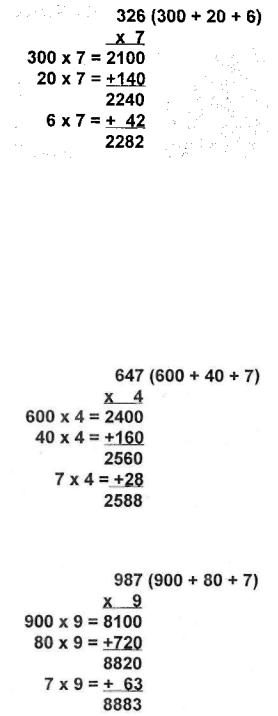
What could be easier? Let's try another 3-by-l problem similar to the one you just did, except we have replaced the 0 with a 6 so that you have another step to perform:
In this case, you simply add the product of 6 x 7, which you already know to be 42, to the first sum of 2240. Since you do not need to carry any numbers, it is easy to add 42 to 2240 to arrive at the total of 2282.
In solving this and other 3-by-l multiplication problems, the difficult part may be holding in memory the first sum (in this case, 2240) while doing the next multiplication problem (in this case, 6 x 7). There is no magic secret to remembering that first number, but with practice I guarantee you will improve your concentration so that holding on to numbers while performing other functions will get easier.
Let's try another problem:
Even if the numbers are large, the process is just as simple. For example:
When first solving these problems, you may have to glance down at the page as you go along to remind yourself what the original problem was. This is okay at first. But try to break the habit so that eventually you are holding the problem entirely in memory.
22
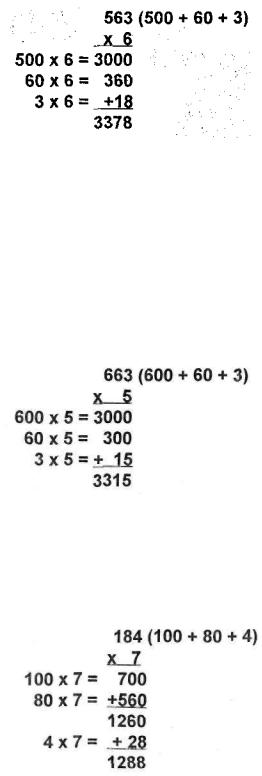
In the last section on 2-by-l multiplication problems, we saw that problems involving numbers that begin with 5 are sometimes especially easy to solve. The same is true for 3-by-l problems:
Notice that whenever the first product is a multiple of 1000, the resulting addition problem is no problem at all because you do not have to carry any numbers and the thousands digit does not change. If you were solving the problem above in front of an audience, you would be able to say your first product—"3000..."—out loud with complete confidence that a carried number would not change it to 4000. (As an added bonus, by quickly saying the first digit, it gives the illusion that you computed the answer immediately!) Even if you are practicing alone, saying your first product out loud frees up some memory space while you work on the remaining 2-by-l problem, which you can say out loud as well—in this case, "...three hundred seventy-eight."
Try the same approach in solving the next problem, where the multiplier is a 5:
Because the first two digits of the 3-digit number are even, you can say the answer as you calculate it without having to add anything! Don't you wish all multiplication problems were so easy?
Let's escalate the challenge by trying a couple of problems that require you to carry a number.
23
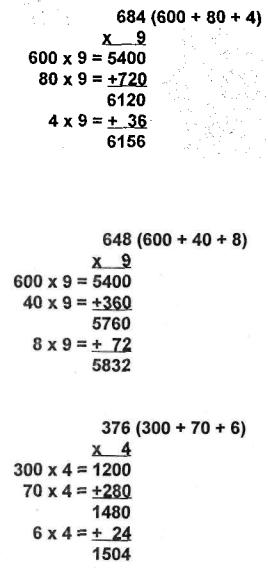
In the next two problems you need to carry a number at the end of the problem instead of at the beginning:
The first part of each of these problems is easy enough to compute mentally. The difficult part comes in holding the preliminary answer in your head while computing the final answer. In the case of the first problem, it is easy to add 5400 + 360 = 5760, but you may have to repeat 5760 to yourself several times while you multiply 8 x 9 = 72. Then add 5760 + 72. Sometimes at this stage I will start to say my answer aloud before finishing. Because I know I will have to carry when I add 60 + 72, I know that 5700 will become 5800, so I say "fifty-eight hundred..." Then I pause to compute 60 + 72 = 132. Because I have already carried, I say only the last two digits, "...and thirty-two!" And there is the answer: 5832.
The next two problems require you to carry two numbers each, so they may take you longer than those you have already done. But with practice you will get faster:
24
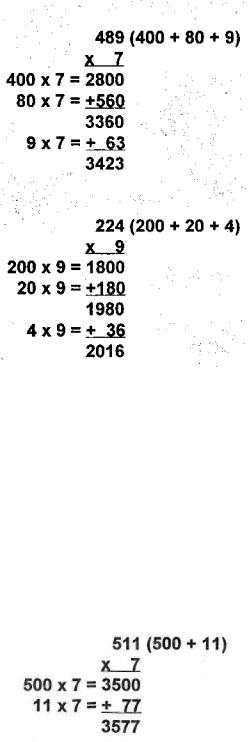
When you are first tackling these problems, repeat the answers to each part out loud as you compute the rest. In the first problem, for example, start out by saying, "Twenty-eight hundred plus five hundred and sixty" a couple of times out loud to reinforce the two numbers in memory while you add them together. Repeat the answer— "thirty-three hundred and sixty"—several times while you multiply 9 x 7 = 63. Then repeat "thirty-three hundred and sixty plus sixty-three" aloud until you compute the final answer of 3423. If you are thinking fast enough to recognize that adding 60 + 63 will require you to carry a 1, you can begin to give the final answer a split second before you know it—"thirty-four hundred...and twenty-three!"
Let's end this section on 3-by-l multiplication problems with some special problems you can do in a flash because they require one addition step instead of two:
25
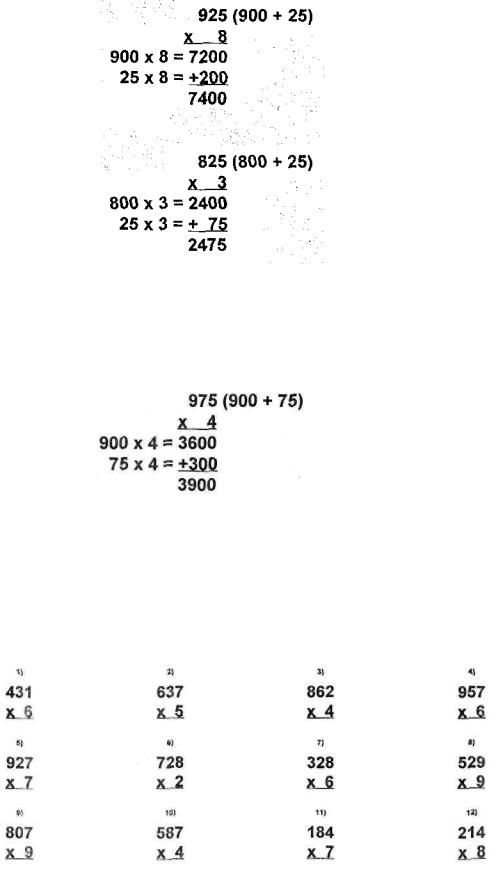
In general, if the product of the last two digits of the first number and the multiplier is known to you without having to calculate it (for instance, you may know that 25 x 8 = 200 automatically since 8 quarters equals $2.00), you will get to the final answer much more quickly. For instance, if you know without calculating that 75 x 4 = 300, then it is a breeze to compute 975 x 4:
To reinforce what you have just learned, solve the following 3-by-l multiplication problems in your head; then check your computations and answers with ours (in the back of the book). I can assure you from experience that doing mental calculations is just like riding a bicycle or typing. It might seem impossible at first, but once you've mastered it, you will never forget how to do it.
Exercises: 3-by-l Multiplication
26

SQUARING 2-DIGIT NUMBERS
Squaring numbers in your head (multiplying a number by itself) is one of the easiest yet most impressive feats of mental calculation you can do. I can still recall where I was when I discovered how to do it. I was 14, sitting on a bus on the way to visit my father at work in downtown Cleveland. It was a trip I made often, so my mind began to wander. I'm not sure why, but I began thinking about the numbers that add up to 20. How large could the product of two such numbers get?
27
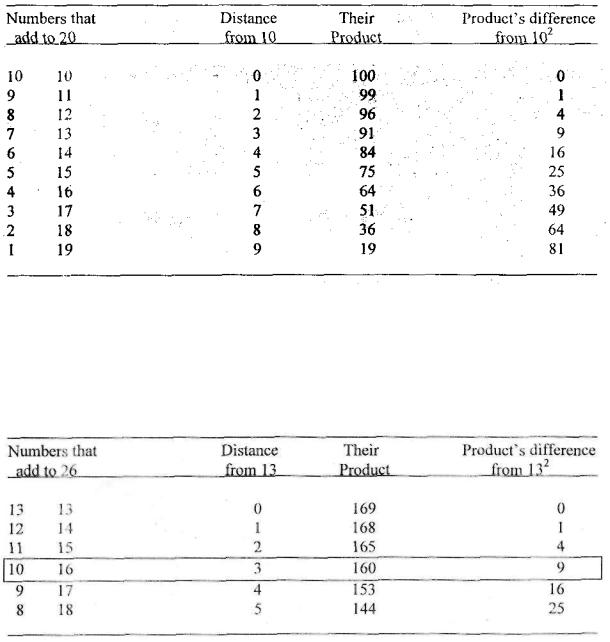
2
1 started in the middle with 10 x 10 (or 10 ), the product of which is 100. Next, I multiplied 9 x 11 = 99, 8 x 12 = 96, 7 x 13 = 91, 6 x 14 = 84, 5 x 15 = 75, 4 x 16 = 64, and so on. I noticed that the products were getting smaller, and their difference from 100 was 1,4, 9, 16, 25, 36—or 12 , 22 , 32 , 42, 52 , 62 (see figure below)
I found this pattern astonishing. Next I tried numbers that add to 26 and got
similar results. First I worked out 13 =169, then computed 12 x 14 = 168, 11 x 15 = 165, 10 x 16 = 160, 9 x 17 = 153, and so on. Just as before, the distance these products
2 2 2 2
were from 169 was 1 , 2 , 3 , 4 , and so on (see figure below).
There is actually a simple algebraic explanation for this phenomenon (see the last section of this chapter). At the time, I didn't know my algebra well enough to prove that this pattern would always occur, but I experimented with enough examples to become convinced of it.
28
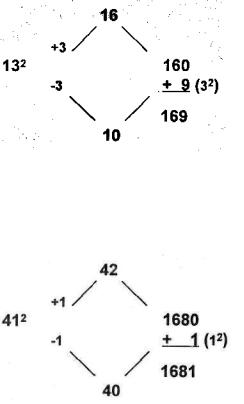
Then I realized this pattern could help me square numbers more easily.
Suppose I wanted to square the number 13, I said to myself. Instead of multiplying 13 x 13, why not get an approximate answer by using two numbers that are easier to multiply but also add up to 26? I chose 10 x 16 = 160. To get an answer, I just
added 3 (since 10 and 16 are each 3 away from 13). Since 3 = 9, 13. = 160 + 9 = 169. Neat!
This method is diagrammed as follows:
Now let's see how this works for another square:
To square 41, subtract 1 to obtain 40 and add 1 to obtain 42. Next multiply 40 x 42. Don't panic! This is simply a 2-by-l multiplication problem (specifically, 4 x 42) in disguise. Since 4 x 42 = 168, 40 x 42 = 1680. Almost done! All you have to add is the square of 1 (the number by which you went up and down from 41), giving you 1680 + 1 = 1681.
29
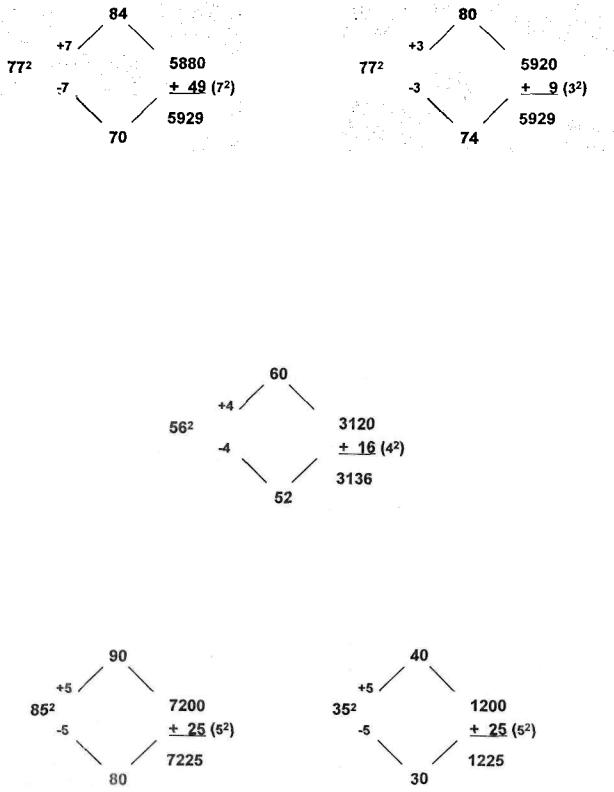
Can squaring a 2-digit number be this easy? Yes, with this method and a little practice, it can. And it works whether you initially round down or round up. For example,
let's examine 77 , working it out both by rounding up and by rounding down:
or
In this instance the advantage of rounding up is that you are virtually done as soon as you have completed the multiplication problem because it is simple to add 9 to a number ending in 0!
In fact, for all 2-digit squares, I always round up or down to the nearest multiple of 10. So if the number to be squared ends in 6, 7, 8, or 9, round up, and if the number to be squared ends in 1,2, 3, 4, round down. (If the number ends in 5, do both!) With this strategy you will add only the numbers 1, 4, 9, 16, or 25 to your first calculation.
Let's try another problem. Calculate 56 in your head before looking at how we did it, below:
Squaring numbers that end in 5 is even easier. Since you will always round up and down by 5, the numbers to be multiplied will both be multiples of 10. Hence, the
multiplication and the addition are especially simple. We have worked out 85 and 35 , below:
30
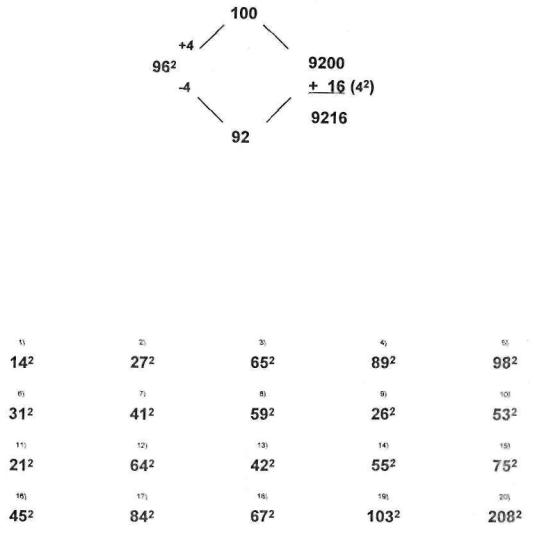
When you are squaring a number that ends in 5, rounding up and down allows you to blurt out the first part of the answer immediately and then finish it with 25. For
example, if you want to compute 75 , rounding up to 80 and down to 70 will give you "Fifty-six hundred...and twenty-five!"
For numbers ending in 5, you should have no trouble beating someone with a calculator, and with a little practice with the other squares, it won't be long before you can beat the calculator with any 2-digit square number. Even large numbers are not to be feared. You can ask someone to give you a really big 2-digit number, something in the high 90's, and it will sound as though you've chosen an impossible problem to compute. But, in fact, these are even easier because they allow you to round up to 100.
Let's say your audience gives you 96 . Try it yourself, and then check how we did
it.
Wasn't that easy? You should have rounded up by 4 to 100 and down by 4 to 92, and then multiplied 100 x 92 for 9200. At this point you can say out loud, "Ninety-two hundred," and then finish up with "sixteen" and enjoy the applause!
Exercises: 2-Digit Squares
Compute the following:
31
